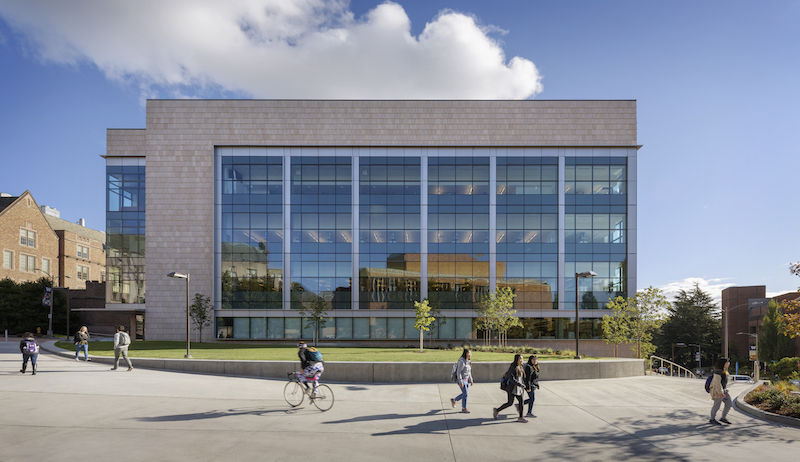In 2012, the 90,000-sf Molecular Engineering and Sciences Building was completed on the University of Washington Campus. This past summer, the five-story, 78,000-sf Nanoengineering and Sciences Building was completed. The two connected buildings make up a 168,000-sf complex that accommodates growth in the molecular engineering and nanoengineering fields, responds to the evolving interdisciplinary nature of teaching and research, and fits within a historic, high-density area of the UW campus.
The new $87.8 million, ZGF Architects-designed nanoengineering building will house the UW Institute for Nano-Engineered Systems and is specifically equipped for the performance or organic, inorganic, and biomolecular synthesis. The limestone, aluminum and glass curtain wall facility can accommodate students and faculty in a variety of nanoengineering disciplines such as energy, materials science, computation, and medicine.
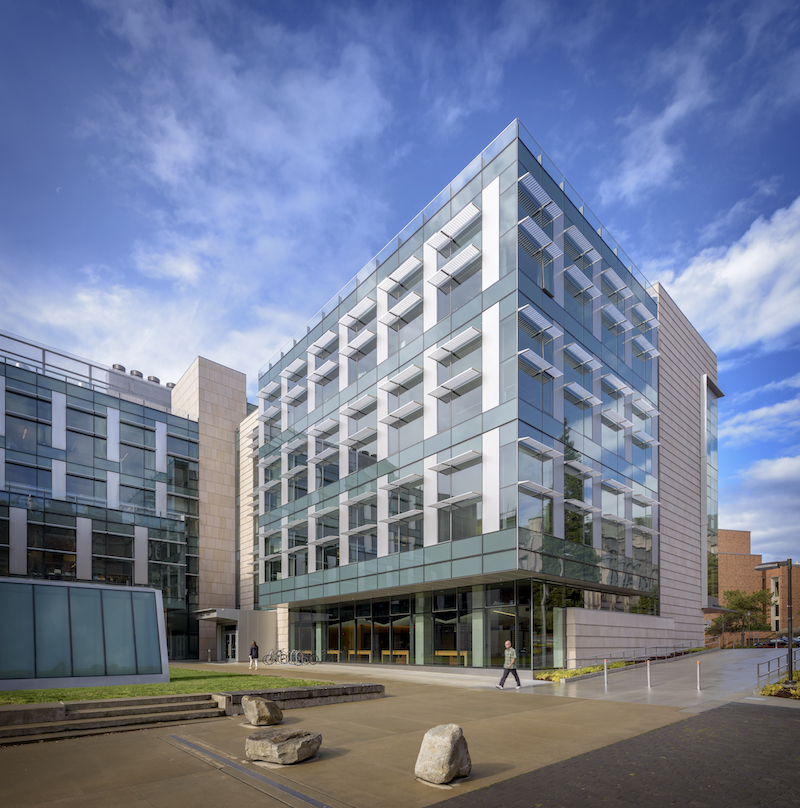 Photo: Aaron Leitz Photography.
Photo: Aaron Leitz Photography.
Flexibility of space was a driver for both phases of the complex. Research labs were designed to adapt as the equipment, research, and faculty change. Overhead service carriers above the lab benches allow for researchers to “plug and play” in any location. At the end of each lab there are rooms that can be arranged to house large equipment or specialty research spaces.
In addition to the labs, the new building also includes general-purpose classrooms, conference rooms, and collaboration spaces. Floors two through four are programmed research laboratory spaces. The first floor includes two highly adaptable classrooms and a shared, informal learning center.
Because the nanoengineering building has mainly southern and northern exposures, ZGF needed a strategy to address the added heat loads to the building due to the different orientation from phase one. Radiant flooring is used for heating and cooling purposes and chilled sails are used in the ceilings along the south wall of the office spaces. The units are ceiling-mounted and flush to the ceiling plane.
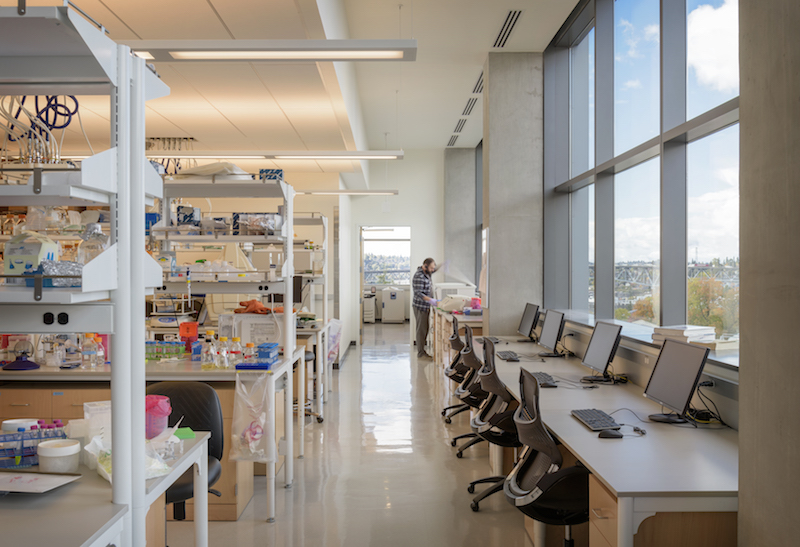 Photo: Aaron Leitz Photography.
Photo: Aaron Leitz Photography.
The new facility incorporates numerous sustainability features such as rain gardens and green roofs planted with vegetation to attract native bees. Stormwater runoff will be directed to the roof gardens to reduce runoff to additional drainage systems.
One of the more unique sustainable features is the use of phase-change materials (PCM). PCM is a gel that becomes warm and liquid during the day and solidifies at night. It is encapsulated in walls and ceiling panels of the naturally ventilated spaces and reduces temperature as it changes material states. The PCM is composed of an inorganic material base and is “charged” at night when windows to office spaces are automatically opened to provide a flush of cool air. The PCM has been shown to reduce the temperature around 1.5 to 2 degrees during peek times on the hottest days of the year.
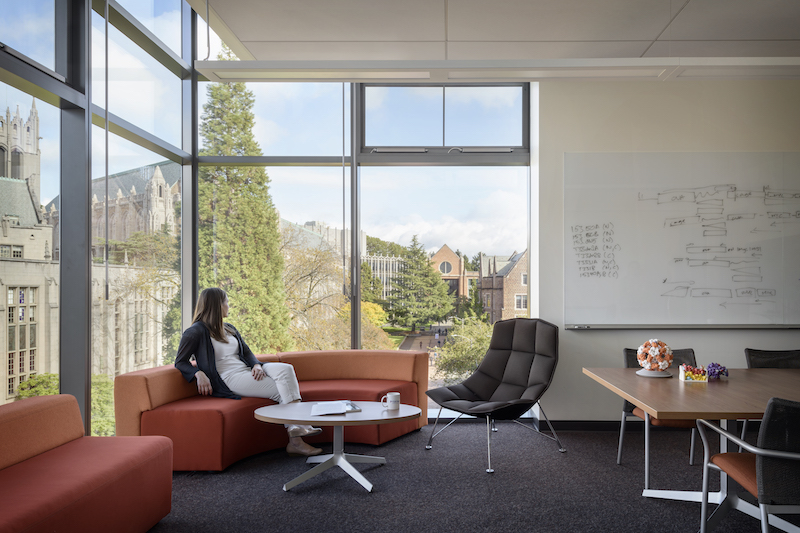 Photo: Aaron Leitz Photography.
Photo: Aaron Leitz Photography.
The building team included Hoffman Construction Company (GC), KPFF (civil engineering, structural engineering), AEI (MEP), Site Workshop (landscape architecture), Research Facilities Design (lab planning), and Studio SC (graphics, wayfinding signage).
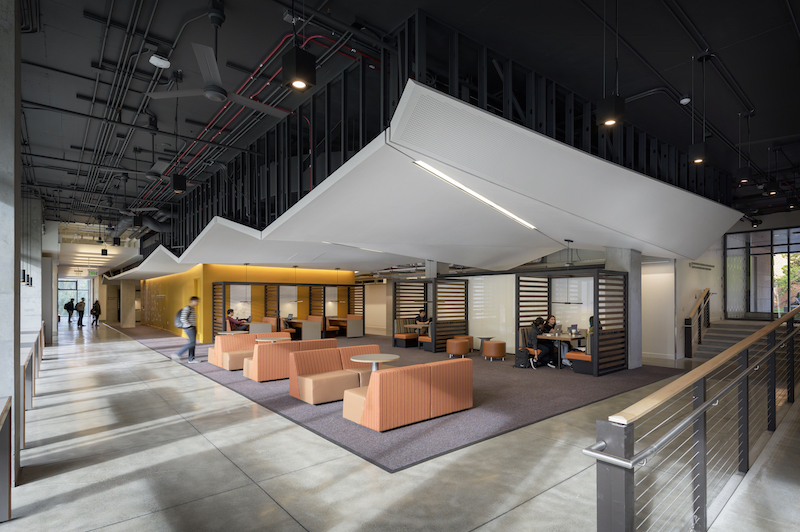 Photo: Aaron Leitz Photography.
Photo: Aaron Leitz Photography.
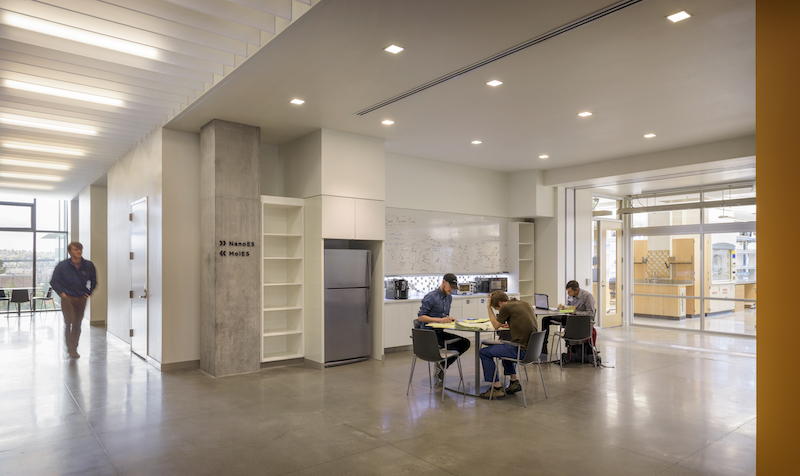 Photo: Aaron Leitz Photography.
Photo: Aaron Leitz Photography.
Related Stories
| May 18, 2011
Raphael Viñoly’s serpentine-shaped building snakes up San Francisco hillside
The hillside location for the Ray and Dagmar Dolby Regeneration Medicine building at the University of California, San Francisco, presented a challenge to the Building Team of Raphael Viñoly, SmithGroup, DPR Construction, and Forell/Elsesser Engineers. The 660-foot-long serpentine-shaped building sits on a structural framework 40 to 70 feet off the ground to accommodate the hillside’s steep 60-degree slope.
| Apr 13, 2011
Duke University parking garage driven to LEED certification
People parking their cars inside the new Research Drive garage at Duke University are making history—they’re utilizing the country’s first freestanding LEED-certified parking structure.
| Apr 12, 2011
Rutgers students offered choice of food and dining facilities
The Livingston Dining Commons at Rutgers University’s Livingston Campus in New Brunswick, N.J., was designed by Biber Partnership, Summit, N.J., to offer three different dining rooms that connect to a central servery.
| Apr 12, 2011
College of New Jersey facility will teach teachers how to teach
The College of New Jersey broke ground on its 79,000-sf School of Education building in Ewing, N.J.
| Mar 23, 2011
After 60 years of student lobbying, new activity center opens at University of Texas
The new Student Activity Center at the University of Texas campus, Austin, is the result of almost 60 years of students lobbying for another dedicated social and cultural center on campus. The 149,000-sf facility is designed to serve as the "campus living room," and should earn a LEED Gold certification, a first for the campus.
| Mar 18, 2011
Universities will compete to build a campus on New York City land
New York City announced that it had received 18 expressions of interest in establishing a research center from universities and corporations around the world. Struggling to compete with Silicon Valley, Boston, and other high-tech hubs, officials charged with developing the city’s economy have identified several city-owned sites that might serve as a home for the research center for applied science and engineering that they hope to establish.
| Mar 15, 2011
What Starbucks taught us about redesigning college campuses
Equating education with a cup of coffee might seem like a stretch, but your choice of college, much like your choice of coffee, says something about the ability of a brand to transform your day. When Perkins + Will was offered the chance to help re-think the learning spaces of Miami Dade College, we started by thinking about how our choice of morning coffee has changed over the years, and how we could apply those lessons to education.
| Mar 11, 2011
University of Oregon scores with new $227 million basketball arena
The University of Oregon’s Matthew Knight Arena opened January 13 with a men’s basketball game against USC where the Ducks beat the Trojans, 68-62. The $227 million arena, which replaces the school’s 84-year-old McArthur Court, has a seating bowl pitched at 36 degrees to replicate the close-to-the-action feel of the smaller arena it replaced, although this new one accommodates 12,364 fans.
| Mar 11, 2011
Historic McKim Mead White facility restored at Columbia University
Faculty House, a 1923 McKim Mead White building on Columbia University’s East Campus, could no longer support the school’s needs, so the historic 38,000-sf building was transformed into a modern faculty dining room, graduate student meeting center, and event space for visiting lecturers, large banquets, and alumni organizations.


